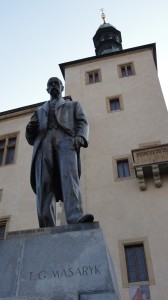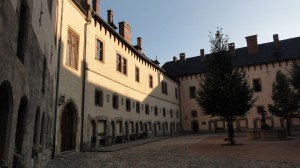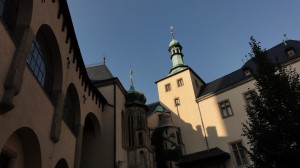The Italian Court (Vlašský dvůr): The royal mint in Kutná Hora
By Tracy A. Burns
A national cultural monument since 1962, the Italian Court is a treasure in Kutná Hora. Not only do visitors learn exciting facts about the minting of coins throughout Czech history, but they also marvel at the Audience Hall and chapel, two of the most beautiful sights in the town. The various architectural styles depicted at the mint are fascinating as well. Coins were made there from 1326 until 1727. The Groschen currency was created at the Italian Court from the early 14th century until 1547.
The beginnings of the Italian Court
 The Italian Court, named after Italian experts who instigated minting reforms, began as a fortified stone mansion under King Wenceslas II (1278-1305). It served as a residence for the king and mining officials. During the 14th century, it was completely renovated, thanks to renowned Czech artisan Petr Parléř. Even during the Hussite wars of the 15th century, the mint continued to produce coins. The significance of the court declined around 1510. By 1545 the place was decrepit.
The Italian Court, named after Italian experts who instigated minting reforms, began as a fortified stone mansion under King Wenceslas II (1278-1305). It served as a residence for the king and mining officials. During the 14th century, it was completely renovated, thanks to renowned Czech artisan Petr Parléř. Even during the Hussite wars of the 15th century, the mint continued to produce coins. The significance of the court declined around 1510. By 1545 the place was decrepit.
The Italian Court from the late 16th century to the late 19th century
 The complex was renovated from 1578 to 1582, but it was damaged by fires at the turn of the 16th and 17th centuries. For the last 200 years, the mint operated under the guidance of the Habsburg Monarchy. In 1770 it was heavily damaged by another fire. During the early 19th century the dilapidated building even served as a prison. After the municipality of Kutná Hora bought the Italian Court in 1881, it was reconstructed, and the town hall, the archives, and a school were located on the premises.
The complex was renovated from 1578 to 1582, but it was damaged by fires at the turn of the 16th and 17th centuries. For the last 200 years, the mint operated under the guidance of the Habsburg Monarchy. In 1770 it was heavily damaged by another fire. During the early 19th century the dilapidated building even served as a prison. After the municipality of Kutná Hora bought the Italian Court in 1881, it was reconstructed, and the town hall, the archives, and a school were located on the premises.
The Audience Hall
The Audience Hall hails from the 14th century, though it got its current appearance in the 19th century. The town symbol – two miners, a lion, a crown, and an eagle – is depicted between two windows. Several significant events in Czech history took place in the Audience Hall. Two paintings in the hall show off these events – the issuing of the Kutná Hora Decree in 1409 and the election of 15-year-old Vladislav Jagiellon as Bohemian King in 1471. In the painting focusing on the decree that limited the influence of foreigners at Prague University, priest, philosopher, and martyr Jan Hus is shown as a big and thin man, while in reality, he was short and bald. A seated King Wenceslas IV, who ruled from 1378 to 1419, is in the picture, too. Another historical event that occurred in the Audience Hall concerns a land assembly in 1485. It resulted in a religious treaty between the Catholics and Hussites.
The chapel
Reconstructed from 1893 to 1898, the Chapel of Saint Wenceslas and Saint Ladislaus celebrates Luxembourg Gothic architecture. Three dazzling 15th-century Gothic triptychs adorn the space. The oldest, called “The Death of the Virgin Mary,” was created before 1497 in Nuremberg. Another triptych features saints Wenceslas, Vladislav, Adalbert (Vojtěch) and Ludmila. From 1904 to 1906 stunning Art Nouveau paintings decorated the walls. The symbol of Kutná Hora can be found above the door, while the town panorama figures in the Secession renditions. Various saints are depicted, too. The Virgin Mary with Jesus and angels also makes an appearance. Symbols of knights and miners can be seen on the walls, too. Exquisite stained glass windows hail from the end of the 19th century. The ceiling boasts a gold leaf décor.
Other highlights
 Several Gothic portals remain in the Italian Court. One of these, viewed at the beginning of the tour, goes back to 1510 and includes an inscription from the Bible as well as a double V symbol for King Vladislav Jagiellon. Another portal, dating from 1518, carries the letter L as a symbol of King Ludvík Jagiellon, who reigned in the Czech lands from 1516 to 1526. Don’t forget to touch the 600-year-old column. One touch brings health, happiness, and wealth. A stone fountain in the courtyard dates back to 1740 and features a sculpture of a miner. An exquisitely carved council bench from 1511 has movable seats so that representatives could show their dissatisfaction with the mayor by sitting with their backs to him.
Several Gothic portals remain in the Italian Court. One of these, viewed at the beginning of the tour, goes back to 1510 and includes an inscription from the Bible as well as a double V symbol for King Vladislav Jagiellon. Another portal, dating from 1518, carries the letter L as a symbol of King Ludvík Jagiellon, who reigned in the Czech lands from 1516 to 1526. Don’t forget to touch the 600-year-old column. One touch brings health, happiness, and wealth. A stone fountain in the courtyard dates back to 1740 and features a sculpture of a miner. An exquisitely carved council bench from 1511 has movable seats so that representatives could show their dissatisfaction with the mayor by sitting with their backs to him.
The minting process
The silver that was mined in Kutná Hora went through a complicated process of being ground and washed before it was sorted into pieces of varying quality. At the ore market mine owners bought the best silver and sold it to the Italian Court. To make a coin from the silver, many processes had to take place, including the burning of the silver, the founding of the mint alloy, and the casting of molds.
Coins minted in Kutná Hora
When King Wenceslas II (1278-1305) introduced a mining code that included currency reform, the Prague Groschen was introduced, and minting took place at the Italian Court. This Groschen was 94 percent silver. Under King John of Luxembourg (1310-1346, also called John the Blind), after a five-year interruption period, Groschens of lesser quality were renewed. When Charles IV (1346-1378) was emperor, production of the Groschen was limited. The quality of the coin and the technical level of production had declined. The Groschen continued to be minted in large quantities under King Wenceslas IV (1378-1419), King George of Poděbrady (1458-1471), and King Vladislav II Jagiellon (1471-1516), though during the early 15th-century Hussite wars, the Groschen was only 10 percent silver. In 1483 white money, made with argent or the tincture of silver, came into being and was worth one-seventh of a Groschen. A year earlier, small coins were circulated. At the turn of 1547 and 1548, the light Groschen was introduced, and it was used until 1644.
Thalers, kreuzers and white coins
In 1543 thalers were first struck. Weighing up to 24 grams, they were heavier and bigger than Groschens. They also were 80 percent silver. Krejcars were worth half a thaler or a quarter of a thaler. During the reign of Holy Roman Emperor Rudolf II (1576-1611), coin production increased a great deal, and the first Czech inscription appeared on a coin. Yet after 1600 production decreased again. Kreuzer coins and white coins were in circulation during the early 17th century under Czech King Matthias (1611-1619). Coins were devalued under Holy Roman Emperor Ferdinand II (1619-1637). During the reign of Emperor Charles VI (1711-1740), both mining and minting flourished, but the mint was abolished in 1726.
Weekly salaries of various professions throughout history
When Charles IV was emperor in the 14th century, a carpenter made 20 Groschen per week. During the tenure of Ludvík Jagiellon, a minter made six Groschen in one week. At the end of the 14th century, a cow cost 55 Groschen while a pig cost 23 Groschen. Also, 60 eggs were sold for one Groschen. During the reign of John of Luxembourg, a horse cost 120-140 Groschen, but by the tenure of Rudolf II from 1576 to 1611, inflation had taken hold, and a horse cost 1,030 Groschen. Minters were expected to forge up to 2,000 coins per 12-hour shift.
Why visit the Italian Court?
An underrated sight in Kutná Hora, the Italian Court deserves visitors’ undivided attention. Even if tourists are not especially interested in coins, this architectural wonder will give them a taste of Czech history. The Audience Hall and the chapel are sure to enthrall as well.



